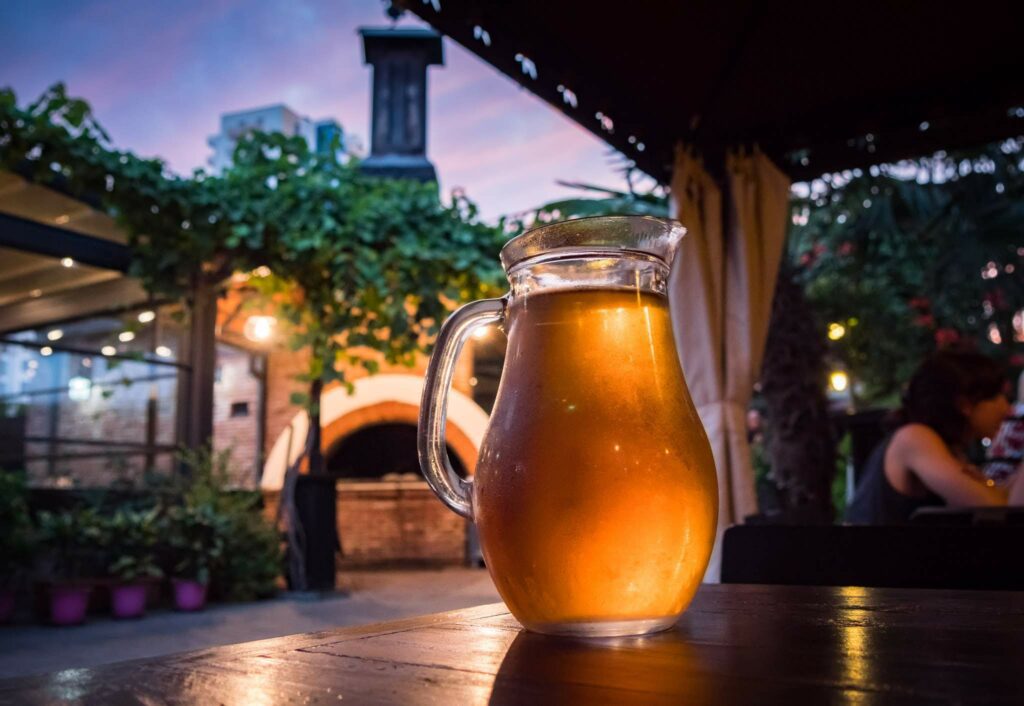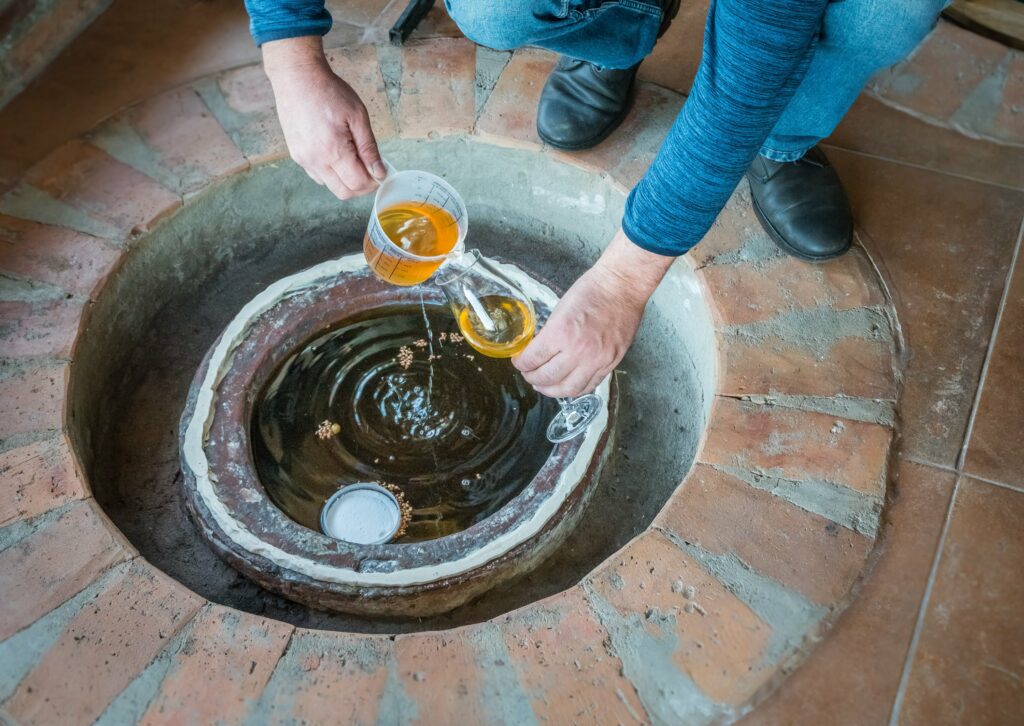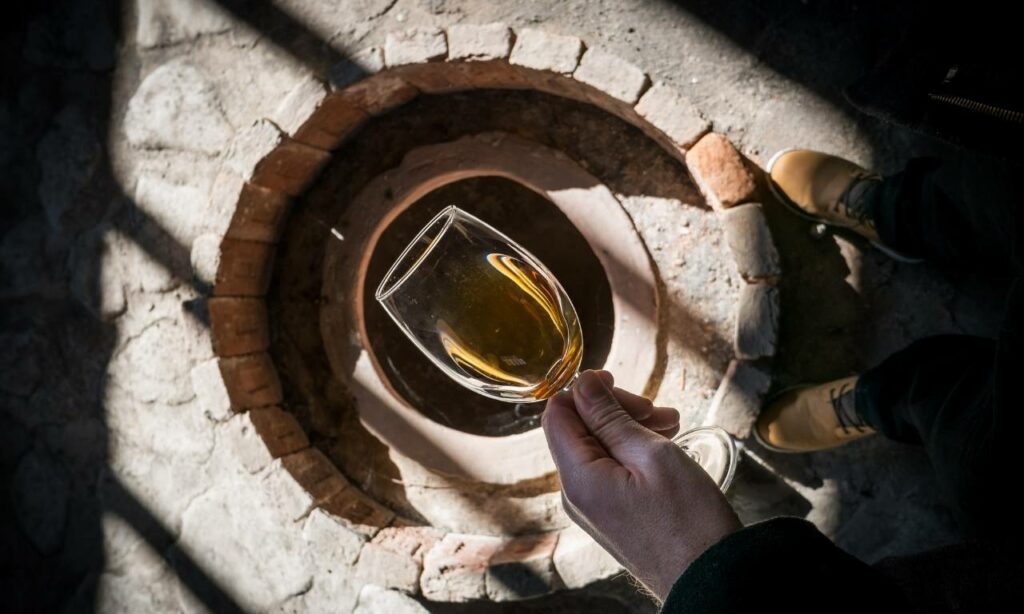Amber wine has been one of the hottest new wine trends around the world recently. With words like “BIO” wine and “Natural” wine also being mentioned and just the fact that this wine can be bright orange, it’s no surprise that more people are interested in trying this new style of wine. But here’s the incredible part. Amber wine isn’t new at all! In fact, it comes from the oldest wine-making tradition in the whole world.
There’s lots more to discover, so get ready, wine lovers! Today, we’re embarking on an adventure into the world of amber wine. It’s a tasty journey of flavour and history. So, grab a glass, and let’s dive in!
The Origin and History of Amber Wine
The journey of amber wine, also sometimes known as orange wine (though this term is confusing as it leads to some people thinking its wine made from oranges – it’s definitely grapes, so let’s all start calling it Amber wine!), starts in the beautiful and historical vineyards of Georgia – the country, not the state.
While the modern wine connoisseur might consider amber wine a recent discovery, its story reaches back more than 8,000 years ago. Yes, you read that right, 8,000 years! Remains of clay jars with remnants of the winemaking process have been carbon-dated to around 6000 BC, showing currently the oldest evidence of winemaking in the world, about 20 miles south of Tbilisi, Georgia’s capital. So, this mesmerizing wine has been around since the time people first decided to turn grapes into something a little bit more fun…
Georgia is a place full of lush vineyards, stretching as far as the eye can see. With many different terroirs that make such an impact on the flavours and style of wine that is produced here.
And over the past 8000 years, the process of turning these grapes into wine has been passed down through the generations and deeply entwines with Georgian culture and tradition. It’s fair to say that amber wine is in their blood. While some of the methods may have evolved, many traditional ways of making amber wine and the traditions that go with it i.e. songs, toasts etc, reflect the historical resilience and identity of the Georgian people.
Even through the hardships of many different occupiers, including most recently Russia (Russia still occupies 20% of Georgian territory), today, Georgia is going through an incredible wine renaissance, and it’s an exciting time to see locals getting excited again about winemaking and rediscovering the 500+ grapes varieties that are endemic to this region. That’s right, 500+ different types of grapes come from Georgia.

What is Amber Wine?
Here’s the thing about amber wine – it’s not some rare unknown coloured grape. It starts life as white wine. The winemakers gather white grapes (Rkatsitelli is the most popular white grape), and instead of following the typical white wine process where the skins are removed right from the start of the fermentation process, they leave the grape skins (and often seeds and even stems) in contact with the juice for anything from a few days to 6+ months. And that’s when the magic happens.
This seemingly small deviation morphs regular white wine into the riveting drink we know as amber wine. Its unique winemaking process sets it apart, putting it in a category all its own – think of it as the ‘fourth’ wine colour. Red, White, Rosé – Amber!
Unlike your typical white wine, it boasts a vibrant spectrum of golden hues, from a soft, light straw to gold-like honey to a bold, deep amber, even caramel in some examples. In addition, some amber wines, though not the majority by any means, do have a bright orange hue.
It’s the extended skin contact that gives amber wine not only its colour but also its characteristic aromas, flavours, and textures. Plus – tannins! Amber wines have more similarities to red winemaking than white. So if you are normally a fan of red and don’t drink white, then amber may be just right for you. It’s a whole different ballpark from your standard whites or rosés, and it’s got a delightful personality all its own!

A Quick Look at How Amber Wine is Made
Let’s dive into the fascinating and ancient process of how amber wine is made. Traditional amber wine-making is quite the process – but worth it, of course. They’d start by throwing a mix of grapes, sometimes even leaves, stems, seeds – the lot! into a massive (ranging from 50 to 3,000 litres, typically) egg-shaped clay amphora (jar or vase), known as a Qvevri.
At each winemaker’s “marani” (wine cellar, Qvevri’s are already buried underground, with only the opening at the top visible. Being buried helps to keep the wine at a stable temperature. Spontaneous fermentation due to natural yeast on the skins begins and can last 1 to 3 weeks on average.
After fermentation, the qvevri’s are then sealed, and the grapes are left to age on the skins . How long the skins are left depends on the winemaker, the style of wine they’re trying to make, and lots of other factors. In Kakheti, Georgia’s most famous wine region, the traditional method often allows for 6 months of skin contact! Though, winemakers today are experimenting with much shorter skin contact, and this is creating huge diversity in amber wines.

In other parts of Georgia, like Imereti, they often only include 30% of the skins. Leading to lighter amber wines, often pale straw in colour and with much lower tannins than the bold wines of Kakheti.
Once the winemaker decides to remove the skins, the wine is often racked into a smaller qvevri for longer term storage and aging. The skins are then used to make “chacha”, Georgian grappa. It’s typical in Georgia to mostly drink young wines, as families would drink through all their wine and then the qvevri’s would be empty in time for the next harvest. However, as the economy develops, the ability to be able to store wines much longer is happening more frequently, leading to even more exciting and unique types of amber wine.
Today’s winemakers, while preserving the essence of the traditional process, have introduced some modern techniques. The Qvevri has sometimes been replaced with stainless steel tanks and oak barrels, but the soul of the process, the skin contact, remains non-negotiable with amber wines. Whether it’s made in a centuries-old Georgian home cellar or a state-of-the-art winery, amber wine’s unique character springs from its special fermentation and maceration process.

What Does Amber Wine Taste Like?
Now onto the fun part – what does amber wine taste like? Let’s set the scene. Imagine a beautiful, sunny afternoon. You pour yourself a glass of amber wine and take a sip. Boom! A burst of flavors hits you. The taste of amber wine is a surprise party for your palate. It boasts a rich, bold taste, often with a tannic kick that you wouldn’t expect from a white wine.
You might catch notes of honey, dried fruit, and nuts, balanced by a pleasing, rustic edge. Some even detect a hint of spice or a whiff of something wild and earthy or smokey. A wide spectrum of fruits can be discovered. From red apple to pineapple. Orange peel to persimmon. Peach to kiwi. Each bottle offers a unique symphony of flavours – you never quite know what you’re going to get.
The longer the grape skins mingle with the juice, the more intriguing the flavour profile can become. The best part? No two amber wines are the same – each one is a new flavour adventure waiting to happen. So, the next time you’re in the mood for something out of the ordinary, remember, amber wine has got you covered!
But heads up! There can be a bit of an adjustment phase while you get used to this style of wine if you are used to drinking European-style white wines. But never fear – we have a LOT of experience in helping people ease into drinking Georgian wines and can help you discover some new favourites.
If you can make the trip to Georgia, come explore Georgian amber wines, and reds too, with us!
 Join Our Georgian Food & Wine Tours!
Join Our Georgian Food & Wine Tours!
Join our small group tours for an enriching cultural adventure, where truly authentic food and wine experiences take center stage!
Where to Buy Amber Wine
This may be a little trickier to answer. You may be able to find Georgian amber wines at your local wine shop, or you can take a dive into the world of online shopping.
Here are a few sellers that we know are stocking Georgian amber wine:
USA
Ghvinos – (only California) https://ghvinos.com/collections/featured-collection
Georgian Wine House Distributors: http://georgianwinehouse.com/category/3/Distribution
UK
Wine of Georgia – https://www.wineofgeorgia.co.uk/collections/
Hedonism Wines – https://hedonism.co.uk/wines/georgian-wine
AUSTRALIA
Tamada – https://www.tamada.com.au/collections/georgian-wine
GERMANY
8000 Vintages Berlin – Großbeerenstraße 27A, 10963 Berlin, Germany

Amber wine is like discovering an awesome classic rock song that just hits right in today’s modern world. It’s unique, has character, and is quickly gaining popularity. So, next time you’re bored with always drinking the same old style of wine – give amber wine a shot!
Want to keep exploring? We have plenty of resources both here and on our Georgian wine tours website to help you dive deeper into the tasty world of Georgian wine. So, keep tasting, keep discovering, and most importantly – keep enjoying wine!







